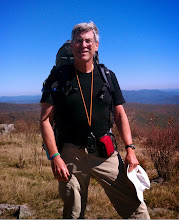Prior Post: Life at the AMC Huts
After hiking about 47 miles across the White Mountains, I suppose that I learned a thing or two. If any of my hiking companions happen to see this, maybe they can add comments with some of their thoughts.
1. Toughness of the Trails: I'd hiked in northern New England many times in the past, but I'd forgotten how tough the trails are. I would look at the topo maps and see lots of ups and downs. But what I didn't understand was the extreme steepness of many parts of the trails, and the fact that most of the trail was littered with large rocks and boulders. So when planning a hike of say, eight miles, I would assume that we could do it in about six hours. In most cases, I was averaging about a mile an hour, or even less. We had much longer days on our feet while we hiked these trails. Someone in better shape and younger than me could do it faster, but I should have realized how tough it would be.
2. Conditioning. Being able to hike a tough trail is based on age and conditioning. I can't do anything about my age, but I should have done more on conditioning. I was walking a lot, and I was climbing stairs at work until I retired. After retirement, I did some backpacking and day hikes with an extra heavy pack. I also hiked 70 miles in Pennsylvania, and I assumed that would prepare me fully, but it didn't. To fully prepare, I should have done more tough hikes. An example: load a backpack fully and hike up Old Rag. Turn around at the summit and hike back down the rocky part. Turn around and hike to the summit. Repeat several times. Or, load a backpack and hike up a really steep trail, like the the AT up the Priest from Tie River. It wouldn't duplicate the rockiness, but the grade is extreme. And in the gym, tons of squats, lunges, and step-ups, and walk with a heavy pack on a treadmill with as steep an incline as possible, or on an elliptical machine. For an old guy, I am in decent shape, but in the White Mountains, decent isn't good enough. Mother Nature gives no one a pass. The youngest guy on the hike, who was 29, did much less hiking to prepare than I did, but was able to hike more quickly and easily than me. He was very fit, but there is also no substitute for youth.
3. Be more mindful of lightening. We knew a storm was in the area, but couldn't fully see the sky because of mountains. When we learned a storm was upon us, we were lucky to get to a sheltered area. We should have been more alert and mindful.
4. Watch pack weight. I was satisfied carrying extra clothing, because when I got soaked, being able to change into dry clothing was worth the weight. But I did carry too much food, about five pounds for the week. As it turned out, I bought lunch twice, and other times, I could have bought food for lunch at the little store the day of each hike, and maybe have carried only a pound or so of food. As far as water, there was one day I could have carried a little less on the second day because we crossed a stream with about two hours to go, but generally, I carried the right amount.
5. Watch my feet. By the end of the hike, my feet and ankles were badly swollen. I should have soaked them when possible, but there probably was not much I could have done. Maybe some additional stretching would have helped. But it's clear that I bit off more than my feet would have wanted.
6. In the future, if I hike in this area, stay two or more nights in the same hut, and do less miles. That would give the option for day hikes and peak bagging with a smaller pack, or even a zero mile day if my feet were getting battered or the weather was bad.
7. Watch the glasses. When my glasses fogged over in rain and clouds, I was effectively blind. I need to come up with a way to be able to see.
Top 12 Moments in My Racing for a Cure Memories
11 years ago










Sounds like you learned a lot of valuable information on this hike!!
ReplyDeleteYes, indeed. Let's see if I remember those lessons next time.
Delete